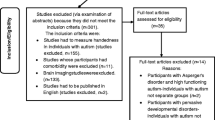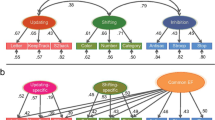Abstract
The P3(00) event-related potential (ERP) component is widely used as a measure of cognitive functioning and provides a sensitive electrophysiological index of the attentional and working memory demands of a task. This study investigated what proportion of the variance in the amplitude and latency of the P3, elicited in a delayed response working memory task, could be attributed to genetic factors. In 335 adolescent twin pairs and 48 siblings, the amplitude and latency of the P3 were examined at frontal, central, and parietal sites. Additive genetic factors accounted for 48% to 61% of the variance in P3 amplitude. Approximately one-third of the genetic variation at frontal sites was mediated by a common genetic factor that also influenced the genetic variation at parietal and central sites. Familial resemblance in P3 latency was due to genetic influence that accounted for 44% to 50% of the variance. Genetic covariance in P3 latency across sites was substantial, with a large part of the variance found at parietal, central, and frontal sites attributed to a common genetic factor. The findings provide further evidence that the P3 is a promising phenotype of neural activity of the brain and has the potential to be used in linkage and association analysis in the search for quantitative trait loci (QTLs) influencing cognition.
Similar content being viewed by others
REFERENCES
Aitken, J. F., Green, A. C., Eldridge, A., Green, L., Pfitzner, J., and Martin, N. G. (1994). Comparability of naevus counts between and within examiners, and comparison with computer image analysis. Br. J. Cancer 69: 487–491.
Almasy, L., Porjesz, B., Blangero, J., Chorlian, D. B., O'Connor, S. J., Kuperman, S., Rohrbaugh, J., Bauer, L. O., Reich, T., Polich J., and Begleiter, H. (1999). Heritability of event-related brain potentials in families with a history of alcoholism. Am. J. Med. Genet. 88: 383–390.
Almasy, L., Porjesz, B., Blangero, J., Goate, A., Edenberg, H. J., Chorlian, D. B., Kuperman, S., O'Connor, S. J., Rohrbaugh, J., Bauer, L. O., Foroud, T., Rice, J. P., Reich, T., and Begleiter, H. (2001). Genetics of event-related brain potentials in response to a semantic priming paradigm in families with a history of alcoholism. Am. J. Hum. Genet. 68: 128–135.
Begleiter, H., and Porjesz, B. (1995). Neurophysiological phenotypic factors in the development of alcoholism. In Begleiter, H., and Kissin, B. (eds.), Alcohol and alcoholism, Vol. 1, New York, Oxford University Press, pp. 269–293.
Begleiter, H., Porjesz, B., Bihari, B., and Kissin, B. (1984). Eventrelated brain potentials in boys at risk for alcoholism. Science 225: 1493–1495.
Begleiter, H., Porjesz, B., Reich, T., Edenberg, H. J., Goate, A., Blangero, J., Almasy, L., Foroud. T., Van Eerdewegh, P., Polich, J., Rohrbaugh, J., Kuperman, S., Bauer, L. O., O'Connor, S. J., Chorlian, D. B., Li, T. K., Conneally, P. M., Hesselbrock, V., Rice, J. P., Schukit, M. A., Cloninger, R., Nurnberger Jr, J., Crowe, R., and Bloom, F. E. (1998). Quantitative trait loci analysis of human event-related brain potentials: P3 voltage. Electroenc. Clin. Neurophysiol. 108: 244–250.
Blackwood, D. H. R., St. Clair, D. M., Muir, W. J., and Duffy, J. C. (1991). Auditory P300 and eye tracking dysfunction in schizophrenic pedigrees. Arch. Gen. Psychiatry 48: 899–909.
Donchin E. (1980). Presidential address, 1980. Surprise!... Surprise? Psychophysiology 18: 493–513.
Duncan-Johnson, C. C., and Donchin, E. (1977). On quantifying surprise: The variation of event-related potentials with subjective probability. Psychophysiology 14: 456–467.
Egan, V. G., Chiswick, A., Brettle, R. P., and Goodwin, G. M. (1992). The Edinburgh cohort of HIV-positive drug users: The relationship between auditory P3 latency, cognitive function and self-rated mood. Psychol. Med. 23: 613–622.
Egan, V. G., Chiswick, A., Santosh, C., Naidu, K., Rimmington, J. E., and Best, J. J. K. (1994). Size isn't everything: A study of brain volume, intelligence and auditory evoked potentials. Pers. Indiv. Differ. 17: 357–367.
Eischen, S., and Polich, J. (1994). P300 from families. Electroenc. Clin. Neurophysiol. 92: 369–372.
Ford, J. M., White, P., Lim, K. O., and Pfefferbaum, A. (1994). Schizophrenics have fewer and smaller P300s: A single-trial analysis. Biol. Psychiat. 35: 96–103.
Geffen, G. M., Wright, M. J., Green, H. J., Gillespie, N. A., Smyth, D. C., Evans, D. M., and Geffen, L. B. (1997). Effects of memory load and distraction on performance and event-related slow potentials in a visuospatial working memory task. J. Cogn. Neurosci. 9: 743–757.
Gevins, A., and Smith, M. E. (2000). Neurophysiological measures of working memory and individual differences in cognitive ability and cognitive style. Cereb. Cortex 10: 829–839.
Hansell, N. K., Wright, M. J., Geffen, G. M., Geffen, L. B., Smith, G. A., and Martin, N. G. (2001). Genetic influence on ERP slow wave measures of working memory. Behav. Genet. 31: 603–613.
Houlihan, M., Stelmack, R., and Campbell, K. (1998). Intelligence and the effects of perceptual processing demands, task difficulty and processing speed on P300, reaction time and movement time. Intelligence 26: 9–25.
Howard, L., and Polich, J. (1985). P300 latency and memory span development. Dev. Psychol. 21: 283–289.
Katsanis, J., Iacono, W. G., McGue, M. K., and Carlson, S. R. (1997). P300 event-related potential heritability in monozygotic and dizygotic twins. Psychophysiology 34: 47–58.
Magliero, A., Bashore, T. R., Coles, M. G., and Donchin E. (1984). On the dependence of P300 latency on stimulus evaluation processes. Psychophysiology 21: 171–186.
McCarthy, G., and Donchin, E. (1981). A metric for thought: A comparison of P300 latency and reaction time. Science 211: 77–80.
McGarry-Roberts, P. A., Stelmack, R. M., and Campbell, K. B. (1992). Intelligence, reaction time, and event-related potentials. Intelligence 16: 289–313.
Neale, M. C., and Cardon, L. R. (1992). Methodology for genetic studies of twins and families, The Netherlands, Kluwer Academic Publishers.
Neale, M. C. (1997). Mx: Statistical Modeling, Department of Psychiatry, Box 126 MCV, Richmond, VA 23298.
Nittono, H., Nageishi, Y., Nakajima, Y., and Ullsberger, P. (1999). Event-related potential correlates of individual differences in working memory capacity. Psychophysiology 36: 745–754.
O'Connor, S., Morzorati, S., Christian, J. C., and Li, T.-K. (1994). Heritable features of the auditory oddball event-related potential: Peaks, latencies, morphology and topography. Electroenceph. Clin. Neurophysiol. 92: 115–125.
O'Donnell, B. F., Friedman, S., Squires, N. K., Maloon, A., Dracman, D. A., and Swearer, J. M. (1990). Active and passive P3 latency in dementia: Relationship to psychometric, electroencephalographic, and computed tomographic measures. Neuropsy. Neuropsy. Behav. 3: 164–179.
O'Donnell, B. F., Friedman, S., Swearer, J. M., and Drachman, D. A. (1992). Active and passive P3 latency and psychometric performance: Influence of age and individual differences. Int. J. Psychophysiol. 12: 187–195.
Pelosi, L., and Blumhardt, L. D. (1992). ‘Memory-scanning’ eventrelated potentials: Correlations with verbal and performance scores. Acta Neurol. 14: 304–312.
Pfefferbaum, A., Ford, J. M., and Kraemer, H. C. (1990). Clinical utility of long latency “cognitive” event-related potentials (P3): The cons. Electroenc. Clin. Neurophysiol. 76: 6–12.
Picton, T. W. (1992). The P300 wave of the human event-related potential. J. Clin. Neurophysiol. 9: 456–479.
Polich, J. (1998). P300 clinical utility and control of variability. J. Clin. Neurophysiol. 15: 14–33.
Polich, J., and Burns T. (1987). P300 from identical twins. Neuropsychologia 25: 299–304.
Polich, J., and Martin, S. (1992). P300, cognitive capability, and personality: A correlational study of university undergraduates. Person. Indiv. Differ. 13: 533–543.
Polich, J., and Squire. L. (1993). P300 from amnesic patients with bilateral hippocampal lesions. Electroenc. Clin. Neurophysiol. 86: 408–417.
Polich, J., Howard, L., and Starr, A. (1983). P300 latency correlates with digit span. Psychophysiology 20: 665–669.
Polich, J., Ladish, C., and Burns, T. (1990). Normal variation of P300 in children: Age, memory span, and head size. Int. J. Psychophysiol. 9: 237–248.
Polich, J., Pollock, V. E., and Bloom, F. E. (1994). Meta-analysis of P300 amplitude from males at risk for alcoholism. Psychol. Bull. 115: 55–73.
Porjesz, B., and Begleiter, H. (1996). Effects of alcohol on electrophysiological activity of the brain. In Begleiter, H., and Kissin, B. (eds.), The pharmacology of alcohol and alcohol dependence. New York, Oxford University Press, pp. 207–247.
Porjesz, B., Begleiter, H., and Samuelly, I. (1980). Cognitive deficits in chronic alcoholics and elderly subjects assessed by evoked brain potentials. Acta Psychiatr. Scand. 62: 15–29.
Rogers, T. D., and Deary, J. (1991). The P300 component of the auditory event-related potential in monozygotic and dizygotic twins. Acta Psychiatr. Scand. 83: 412–416.
Roth, W. T., Pfefferbaum, A., Horvath, T. B., Berger, P. A., and Kopell, B. S. (1980). P3 reduction in auditory evoked potentials of schizophrenics. Electroenc. Clin. Neurophysiol. 49: 497–505.
Rugg, M. D., and Coles, M. G. H. (1995). Electrophysiology of the mind: Event related potentials and cognition. Oxford, Oxford University Press.
Schafer, E. (1985). Neural adaptability: A biological determinant of g factor intelligence. Behav. Brain. Sci. 8: 240–241.
Surwillo, W. W. (1980). Cortical evoked potentials in monozygotic twins and unrelated subjects: Comparison of exogenous and endogenous components. Behav. Genet. 10: 201–209.
Turetsky, B., Colbath, E. A., and Gur, R. E. (1998). P300 subcomponent abnormalities in schizophrenia: II. Longitudinal stability and relationship to symptom change. Biol. Psychiat. 43: 31–39.
Turetsky, B. I., Cannon, T. D., and Gur, R. E. (2000). P300 subcomponent abnormalities in schizophrenia: III. Deficits in unaffected siblings of schizophrenic probands. Biol. Psychiat. 47: 380–390.
van Beijsterveldt, C. E. M., Molenaar, P. C. M., de Geus, E. J. C., and Boomsma, D. I. (1998). Individual differences in P300 amplitude: A genetic study in adolescent twins. Biol. Psychol. 47: 97–120.
Verleger, R., Heide, W., Butt, C., and Kompf, D. (1994). Reduction of P3b in patients with temporoparietal leasions. Cog. Brain Res. 2: 102–116.
Williams, J. T., Begleiter, H., Porjesz, B., Edenberg, H. J., Foroud, T., Reich, T., Goate, A., Van Eerdewegh, P., Almasy, L., and Blangero, J. (1999). Joint multipoint linkage analysis of multivariate qualitative and quantitative Traits: II. Alcoholism and event-related potentials. Am. J. Hum. Gen. 65: 1148–1160.
Wright, M., de Geus, E., Ando, J., Luciano, M., Posthuma, D., Ono, Y., Hansell, N., van Baal, C., Hiraishi, K., Hasegawa, T., Smith, G., Geffen, G. M., Geffen, L., Kanba, S., Miyake, A., Martin, N., and Boomsma, D. (2001). Genetics of cognition: Outline of collaborative twin study. Twin Res. 4: 48–56.
Author information
Authors and Affiliations
Rights and permissions
About this article
Cite this article
Wright, M.J., Hansell, N.K., Geffen, G.M. et al. Genetic Influence on the Variance in P3 Amplitude and Latency. Behav Genet 31, 555–565 (2001). https://doi.org/10.1023/A:1013393327704
Issue Date:
DOI: https://doi.org/10.1023/A:1013393327704




